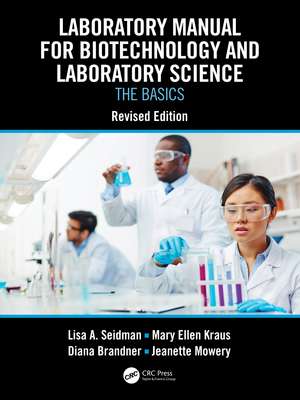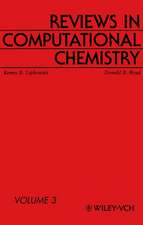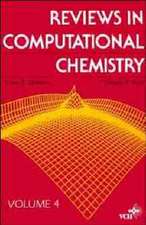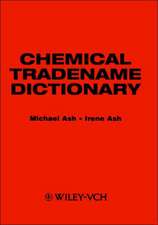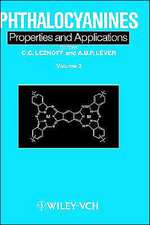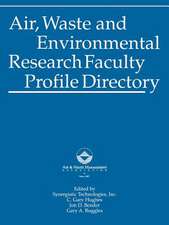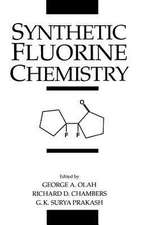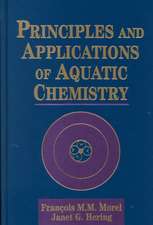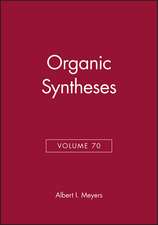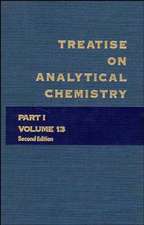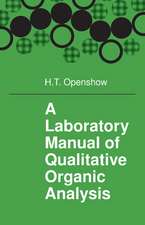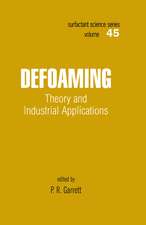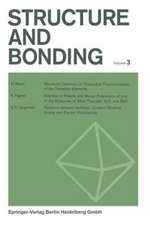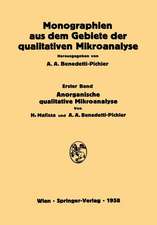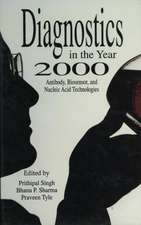Laboratory Manual for Biotechnology and Laboratory Science: The Basics, Revised Edition
Autor Lisa A. Seidman, Mary Ellen Kraus, Diana Lietzke Brandner, Jeanette Moweryen Limba Engleză Paperback – 23 dec 2022
Features:
• Provides clear instructions and step-by-step exercises to make learning the material easier for students.
• Emphasizes fundamental laboratory skills that prepare students for the industry.
• Builds students’ skills through an organized and systematic presentation of materials, procedures, and tasks.
• Updates reflect recent innovations and regulatory requirements to ensure students stay up to date.
• Supplies skills suitable for careers in forensic, clinical, quality control, environmental, and other testing laboratories.
Preț: 513.61 lei
Preț vechi: 558.26 lei
-8% Nou
Puncte Express: 770
Preț estimativ în valută:
98.28€ • 102.87$ • 81.80£
98.28€ • 102.87$ • 81.80£
Carte disponibilă
Livrare economică 10-24 martie
Livrare express 21-27 februarie pentru 49.93 lei
Preluare comenzi: 021 569.72.76
Specificații
ISBN-13: 9781032419916
ISBN-10: 1032419911
Pagini: 444
Ilustrații: 44 Tables, color; 17 Line drawings, color; 74 Line drawings, black and white; 36 Halftones, color; 65 Halftones, black and white; 53 Illustrations, color; 139 Illustrations, black and white
Dimensiuni: 210 x 280 x 23 mm
Greutate: 0.99 kg
Ediția:1
Editura: CRC Press
Colecția CRC Press
ISBN-10: 1032419911
Pagini: 444
Ilustrații: 44 Tables, color; 17 Line drawings, color; 74 Line drawings, black and white; 36 Halftones, color; 65 Halftones, black and white; 53 Illustrations, color; 139 Illustrations, black and white
Dimensiuni: 210 x 280 x 23 mm
Greutate: 0.99 kg
Ediția:1
Editura: CRC Press
Colecția CRC Press
Public țintă
Postgraduate, Professional, Undergraduate Advanced, and Undergraduate CoreCuprins
UNIT I SAFETY IN THE LABORATORY
Unit Introduction
SAFETY PART 1: CREATING A SAFE WORKPLACE
Fundamental Principles
Classroom Activity 1: Performing a Risk Assessment
Classroom Activity 2: Exploring Safety-Related Government Web Sites
Classroom Activity 3: Responding to Emergencies
SAFETY PART 2: WORKING SAFELY WITH CHEMICALS
Fundamental Principles
Classroom Activity 4: Understanding the Chemicals with Which You Work
Classroom Activity 5: Personal Protection
Laboratory Exercise 1: Tracking the Spread of Chemical Contamination
Classroom Activity 6: Analyzing Safety Issues in a Laboratory Procedure
SAFETY PART 3: WORKING SAFELY WITH BIOLOGICAL HAZARDS
Fundamental Principles
Laboratory Exercise 2: Production of Bioaerosols and Factors Affecting Aerosol
Production
Unit Discussion
Safety Contract, student copy
Safety Contract, to turn in
UNIT II DOCUMENTATION IN THE LABORATORY
Unit Introduction
Classroom Activity 7: Being an Auditor
Laboratory Exercise 3: Keeping a Laboratory Notebook
Classroom Activity 8: Writing and Following an SOP
Unit Discussion
UNIT III METROLOGY IN THE LABORATORY
Unit Introduction
Laboratory Exercise 4: Recording Measurements with the Correct Number of Significant
Figures
Classroom Activity 9: Constructing a Simple Balance
Laboratory Exercise 5: Weight Measurements 1: Good Weighing Practices
Laboratory Exercise 6: Weight Measurements 2: Performance Verification
Laboratory Exercise 7: Volume Measurements 1: Proper Use of Volume
Measuring Devices
Laboratory Exercise 8: Volume Measurements 2: Performance Verification of a M Micropipette
Laboratory Exercise 9: Measuring pH with Accuracy and Precision
Unit Discussion
UNIT IV SPECTROPHOTOMETRY AND THE MEASUREMENT OF LIGHT
Unit Introduction
Laboratory Exercise 10: Color and the Absorbance of Light
Laboratory Exercise 11: Concentration, Absorbance, and Transmittance
Laboratory Exercise 12: Preparing a Standard Curve With Food Coloring and Using it for Quantitation
Classroom Activity 10: Beer’s Law and Calculating an Absorptivity Constant
Laboratory Exercise 13: Determination of the Absorptivity Constant for ONP
Unit Discussion
UNIT V BIOLOGICAL SOLUTIONS
Unit Introduction
Classroom Activity 11: Getting Ready to Prepare Solutions with One Solute: Calculations
Classroom Activity 12: Getting Ready to Prepare Solutions with One Solute: Ordering
Chemicals
Laboratory Exercise 14: Preparing Solutions with One Solute
Laboratory Exercise 15: Preparing Solutions to the Correct Concentration
Laboratory Exercise 16: Working with Buffers
Laboratory Exercise 17: Preparing Breaking Buffer
Laboratory Exercise 18: Preparing TE Buffer
Laboratory Exercise 19: More Practice Making a Buffer
Laboratory Exercise 20: Making a Quality Product in a Simulated Company
Unit Discussion
UNIT VI ASSAYS
Unit Introduction
Laboratory Exercise 21: Two Qualitative Assays
Laboratory Exercise 22: UV Spectrophotometric Assay of DNA: Quantitative Application
Laboratory Exercise 23: UV Spectrophotometric Assay of DNA and Proteins: Qualitative Applications
Laboratory Exercise 24: The Bradford Protein Assay: Learning the Assay
Laboratory Exercise 25: The Bradford Protein Assay: Exploring Assay Verification
Laboratory Exercise 26: The Beta-Galactosidase Enzyme Assay
Laboratory Exercise 27: Comparing the Specific Activity of Two Preparations of
Beta-Galactosidase
Laboratory Exercise 28: Using Spectrophotometry for Quality Control: Niacin
Unit Discussion
UNIT VII BIOLOGICAL SEPARATION METHODS
Unit Introduction
Classroom Activity 13: Planning for Separating Materials Using a Centrifuge
Laboratory Exercise 29: Separation of Two Substances Based on Their Differential
Affinities for Two Phases
Laboratory Exercise 30: Separation and Identification of Dyes Using Paper
Chromatography
Laboratory Exercise 31: Separating Molecules by Agarose Gel Electrophoresis
Laboratory Exercise 32: Using Agarose Gel Electrophoresis to Perform an Assay
Laboratory Exercise 33: Optimizing Agarose Gel Electrophoresis
Laboratory Exercise 34: Quantification of DNA by Agarose Gel Electrophoresis
Laboratory Exercise 35: Introduction to Ion Exchange Column Chromatography
Unit Discussion
UNIT VIII GROWING CELLS
Unit Introduction
GROWING CELLS PART I: BACTERIAL CELLS
Laboratory Exercise 36: Using a Compound Light Microscope
Laboratory Exercise 37: Aseptic Technique on an Open Lab Bench
Laboratory Exercise 38: Working with Bacteria on an Agar Substrate: Isolating
Individual Colonies
Laboratory Exercise 39: Gram Staining
Laboratory Exercise 40: Preparing Phosphate-Buffered Saline
Laboratory Exercise 41: The Aerobic Spread-Plate Method of Enumerating Colony-
Forming Units
Laboratory Exercise 42: Preparing a Growth Curve for E. coli
GROWING CELLS PART 2: MAMMALIAN CELLS
Laboratory Exercise 43: Aseptic Technique in a Biological Safety Cabinet
Laboratory Exercise 44: Making Ham’s F12 Medium from Dehydrated Powder
Laboratory Exercise 45: Examining, Photographing, and Feeding CHO Cells
Laboratory Exercise 46: Counting Cells Using a Hemocytometer
Laboratory Exercise 47: Subculturing CHO Cells
Laboratory Exercise 48: Preparing a Growth Curve for CHO Cells
Unit Discussion
APPENDICES
1. Abbreviations and Acronyms Used in this Laboratory Manual
2. Glossary
3. Selected Bibliography
4. Brief Metric Review
5. Calculating Standard Deviation
6. Equipment, Supplies, and Reagents Required for Each Unit
7. Recipes and Preparation Notes
Unit Introduction
SAFETY PART 1: CREATING A SAFE WORKPLACE
Fundamental Principles
Classroom Activity 1: Performing a Risk Assessment
Classroom Activity 2: Exploring Safety-Related Government Web Sites
Classroom Activity 3: Responding to Emergencies
SAFETY PART 2: WORKING SAFELY WITH CHEMICALS
Fundamental Principles
Classroom Activity 4: Understanding the Chemicals with Which You Work
Classroom Activity 5: Personal Protection
Laboratory Exercise 1: Tracking the Spread of Chemical Contamination
Classroom Activity 6: Analyzing Safety Issues in a Laboratory Procedure
SAFETY PART 3: WORKING SAFELY WITH BIOLOGICAL HAZARDS
Fundamental Principles
Laboratory Exercise 2: Production of Bioaerosols and Factors Affecting Aerosol
Production
Unit Discussion
Safety Contract, student copy
Safety Contract, to turn in
UNIT II DOCUMENTATION IN THE LABORATORY
Unit Introduction
Classroom Activity 7: Being an Auditor
Laboratory Exercise 3: Keeping a Laboratory Notebook
Classroom Activity 8: Writing and Following an SOP
Unit Discussion
UNIT III METROLOGY IN THE LABORATORY
Unit Introduction
Laboratory Exercise 4: Recording Measurements with the Correct Number of Significant
Figures
Classroom Activity 9: Constructing a Simple Balance
Laboratory Exercise 5: Weight Measurements 1: Good Weighing Practices
Laboratory Exercise 6: Weight Measurements 2: Performance Verification
Laboratory Exercise 7: Volume Measurements 1: Proper Use of Volume
Measuring Devices
Laboratory Exercise 8: Volume Measurements 2: Performance Verification of a M Micropipette
Laboratory Exercise 9: Measuring pH with Accuracy and Precision
Unit Discussion
UNIT IV SPECTROPHOTOMETRY AND THE MEASUREMENT OF LIGHT
Unit Introduction
Laboratory Exercise 10: Color and the Absorbance of Light
Laboratory Exercise 11: Concentration, Absorbance, and Transmittance
Laboratory Exercise 12: Preparing a Standard Curve With Food Coloring and Using it for Quantitation
Classroom Activity 10: Beer’s Law and Calculating an Absorptivity Constant
Laboratory Exercise 13: Determination of the Absorptivity Constant for ONP
Unit Discussion
UNIT V BIOLOGICAL SOLUTIONS
Unit Introduction
Classroom Activity 11: Getting Ready to Prepare Solutions with One Solute: Calculations
Classroom Activity 12: Getting Ready to Prepare Solutions with One Solute: Ordering
Chemicals
Laboratory Exercise 14: Preparing Solutions with One Solute
Laboratory Exercise 15: Preparing Solutions to the Correct Concentration
Laboratory Exercise 16: Working with Buffers
Laboratory Exercise 17: Preparing Breaking Buffer
Laboratory Exercise 18: Preparing TE Buffer
Laboratory Exercise 19: More Practice Making a Buffer
Laboratory Exercise 20: Making a Quality Product in a Simulated Company
Unit Discussion
UNIT VI ASSAYS
Unit Introduction
Laboratory Exercise 21: Two Qualitative Assays
Laboratory Exercise 22: UV Spectrophotometric Assay of DNA: Quantitative Application
Laboratory Exercise 23: UV Spectrophotometric Assay of DNA and Proteins: Qualitative Applications
Laboratory Exercise 24: The Bradford Protein Assay: Learning the Assay
Laboratory Exercise 25: The Bradford Protein Assay: Exploring Assay Verification
Laboratory Exercise 26: The Beta-Galactosidase Enzyme Assay
Laboratory Exercise 27: Comparing the Specific Activity of Two Preparations of
Beta-Galactosidase
Laboratory Exercise 28: Using Spectrophotometry for Quality Control: Niacin
Unit Discussion
UNIT VII BIOLOGICAL SEPARATION METHODS
Unit Introduction
Classroom Activity 13: Planning for Separating Materials Using a Centrifuge
Laboratory Exercise 29: Separation of Two Substances Based on Their Differential
Affinities for Two Phases
Laboratory Exercise 30: Separation and Identification of Dyes Using Paper
Chromatography
Laboratory Exercise 31: Separating Molecules by Agarose Gel Electrophoresis
Laboratory Exercise 32: Using Agarose Gel Electrophoresis to Perform an Assay
Laboratory Exercise 33: Optimizing Agarose Gel Electrophoresis
Laboratory Exercise 34: Quantification of DNA by Agarose Gel Electrophoresis
Laboratory Exercise 35: Introduction to Ion Exchange Column Chromatography
Unit Discussion
UNIT VIII GROWING CELLS
Unit Introduction
GROWING CELLS PART I: BACTERIAL CELLS
Laboratory Exercise 36: Using a Compound Light Microscope
Laboratory Exercise 37: Aseptic Technique on an Open Lab Bench
Laboratory Exercise 38: Working with Bacteria on an Agar Substrate: Isolating
Individual Colonies
Laboratory Exercise 39: Gram Staining
Laboratory Exercise 40: Preparing Phosphate-Buffered Saline
Laboratory Exercise 41: The Aerobic Spread-Plate Method of Enumerating Colony-
Forming Units
Laboratory Exercise 42: Preparing a Growth Curve for E. coli
GROWING CELLS PART 2: MAMMALIAN CELLS
Laboratory Exercise 43: Aseptic Technique in a Biological Safety Cabinet
Laboratory Exercise 44: Making Ham’s F12 Medium from Dehydrated Powder
Laboratory Exercise 45: Examining, Photographing, and Feeding CHO Cells
Laboratory Exercise 46: Counting Cells Using a Hemocytometer
Laboratory Exercise 47: Subculturing CHO Cells
Laboratory Exercise 48: Preparing a Growth Curve for CHO Cells
Unit Discussion
APPENDICES
1. Abbreviations and Acronyms Used in this Laboratory Manual
2. Glossary
3. Selected Bibliography
4. Brief Metric Review
5. Calculating Standard Deviation
6. Equipment, Supplies, and Reagents Required for Each Unit
7. Recipes and Preparation Notes
Recenzii
This hefty, 1,171-page, paperback book is worth its weight in gold. What a fantastic reference for the various aspects of biotechnology. I loved the emphasis on the "relationship between proper fundamental practices and reproducibility," and the authors' steadfast commitment to providing a "solid grounding in basic, quality practices" essential for success in biotechnology.
The sheer size and comprehensiveness of this book reinforces their introductory statement, "..'biotechnology' is not a synonym for 'molecular biology.'" Pretty much every possible test method used in a biotechnology setting (e.g., cell culture, chromatography, immunoassay) and their essential quality components (e.g., measurements such as weight and temperature; and solutions - love the declarative statement for section 24.1.1.2: "water is not pure") are described in great detail. Case studies accompany each chapter for the learners to test their retention and understanding. A nice inclusion is the section on regulatory affairs for learners to appreciate the challenges of bringing a biotechnology product to the consumer.
This is a fabulous textbook. If you work in biotechnology, this should be on every workbench and administrative office (e.g., supervisors, regulatory, quality assurance) for easy reference and, most importantly, adherence to
quality practices.
Valerie L Ng, PhD MD(Alameda County Medical Center/Highland Hospital)
The sheer size and comprehensiveness of this book reinforces their introductory statement, "..'biotechnology' is not a synonym for 'molecular biology.'" Pretty much every possible test method used in a biotechnology setting (e.g., cell culture, chromatography, immunoassay) and their essential quality components (e.g., measurements such as weight and temperature; and solutions - love the declarative statement for section 24.1.1.2: "water is not pure") are described in great detail. Case studies accompany each chapter for the learners to test their retention and understanding. A nice inclusion is the section on regulatory affairs for learners to appreciate the challenges of bringing a biotechnology product to the consumer.
This is a fabulous textbook. If you work in biotechnology, this should be on every workbench and administrative office (e.g., supervisors, regulatory, quality assurance) for easy reference and, most importantly, adherence to
quality practices.
Valerie L Ng, PhD MD(Alameda County Medical Center/Highland Hospital)
Notă biografică
Professor Lisa Seidman earned her PhD from the University of Wisconsin and has taught for more than thirty years in the Biotechnology Laboratory Technician Program at Madison Area Technical College. She is presently serving as Emeritus Faculty at the college.
Dr Mary Ellen Kraus has been a faculty member in the Biotechnology Laboratory Technician Program at Madison Area Technical College for more than twenty years. She earned her BS in Biochemistry from the Pennsylvania State University and her PhD in Biochemistry from Cornell University.
Dr Diana Lietzke Brandner earned her MS in Biotechnology Education from the University of Wisconsin-Madison. She has been a Lead Laboratory Coordinator in the Biotechnology Laboratory Technician Program at Madison Area Technical College for more than thirty years.
Professor Jeanette Mowery earned her PhD in Biomedical Science from the University of Texas Health Science Center-Houston. She has taught for more than 20 years in the Biotechnology Laboratory Technician Program at Madison Area Technical College and is currently serving as Emeritus Faculty at the college.
Dr Mary Ellen Kraus has been a faculty member in the Biotechnology Laboratory Technician Program at Madison Area Technical College for more than twenty years. She earned her BS in Biochemistry from the Pennsylvania State University and her PhD in Biochemistry from Cornell University.
Dr Diana Lietzke Brandner earned her MS in Biotechnology Education from the University of Wisconsin-Madison. She has been a Lead Laboratory Coordinator in the Biotechnology Laboratory Technician Program at Madison Area Technical College for more than thirty years.
Professor Jeanette Mowery earned her PhD in Biomedical Science from the University of Texas Health Science Center-Houston. She has taught for more than 20 years in the Biotechnology Laboratory Technician Program at Madison Area Technical College and is currently serving as Emeritus Faculty at the college.
Descriere
Provides the basic laboratory skills and knowledge to pursue a career in biotechnology. Building skills through an organized and systematic presentation of materials, procedures, and tasks, it explores overarching themes that relate to all workplaces including forensic, clinical, quality control, environmental, and other testing laboratories.
